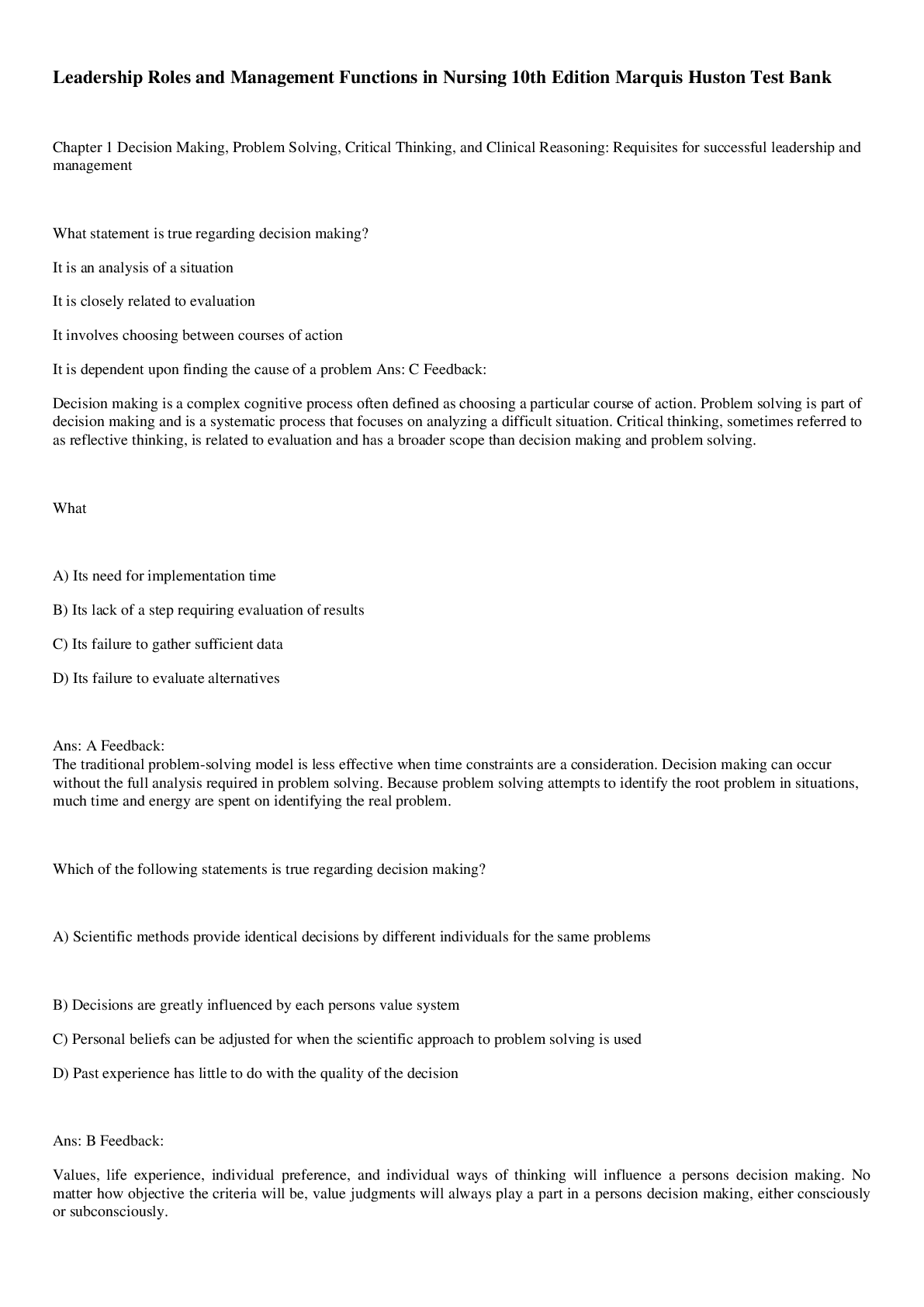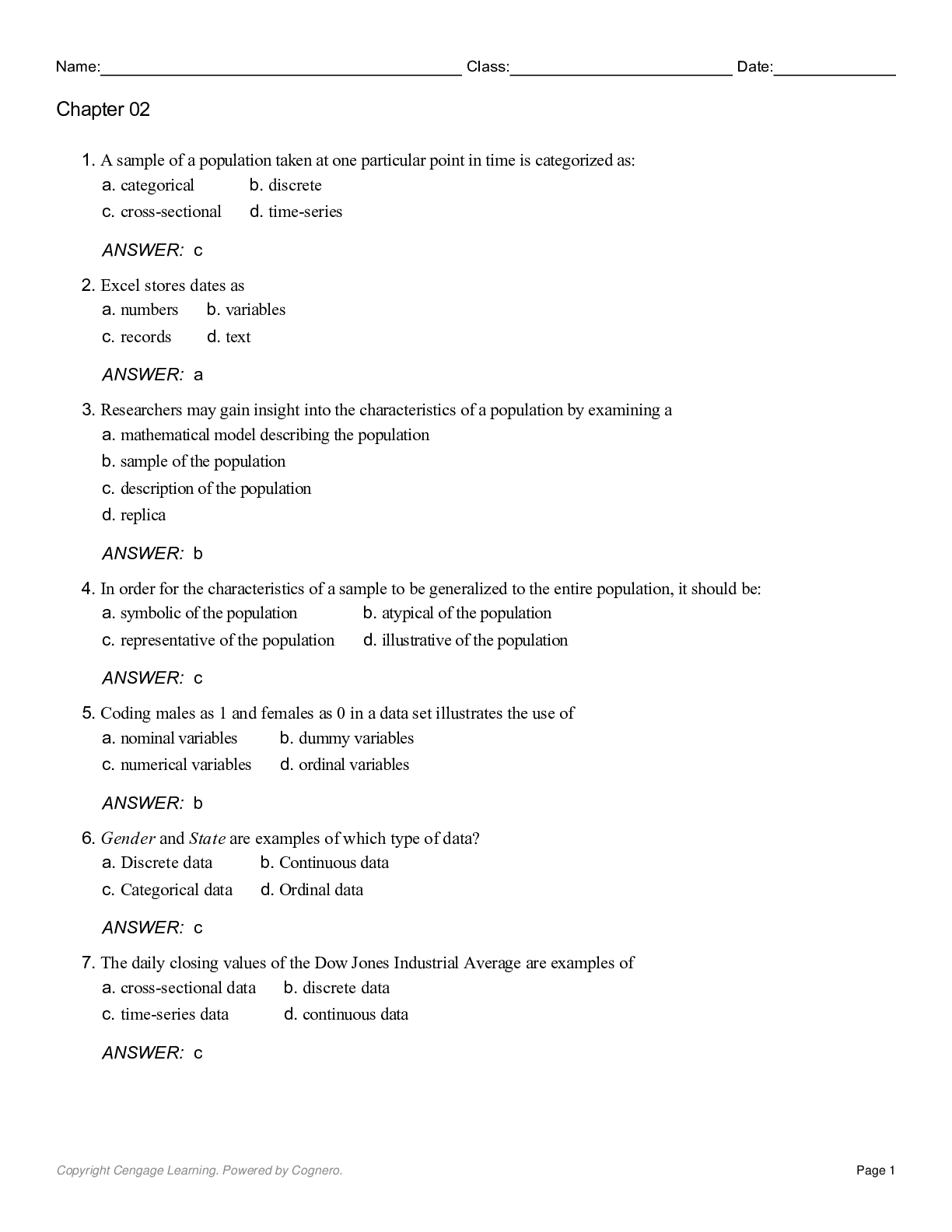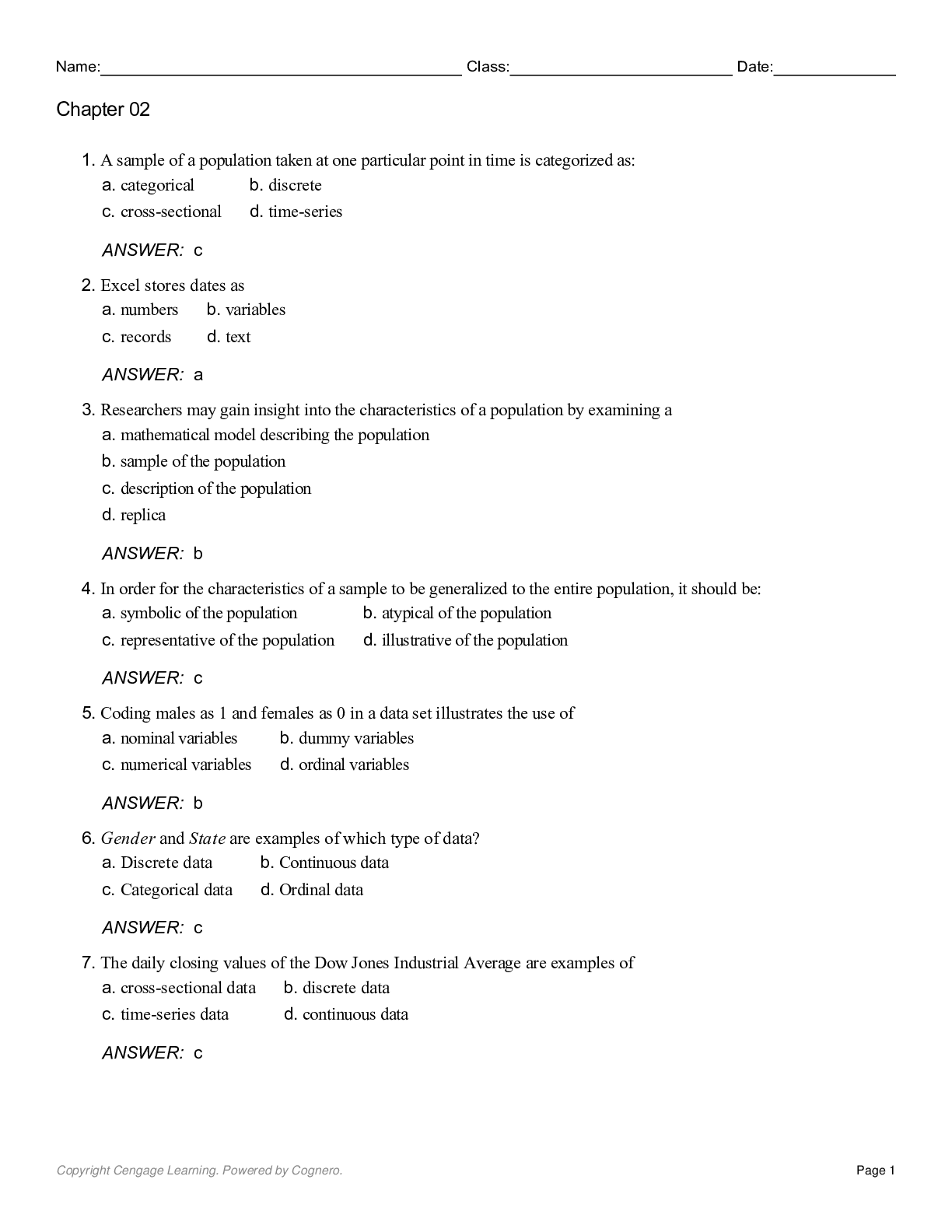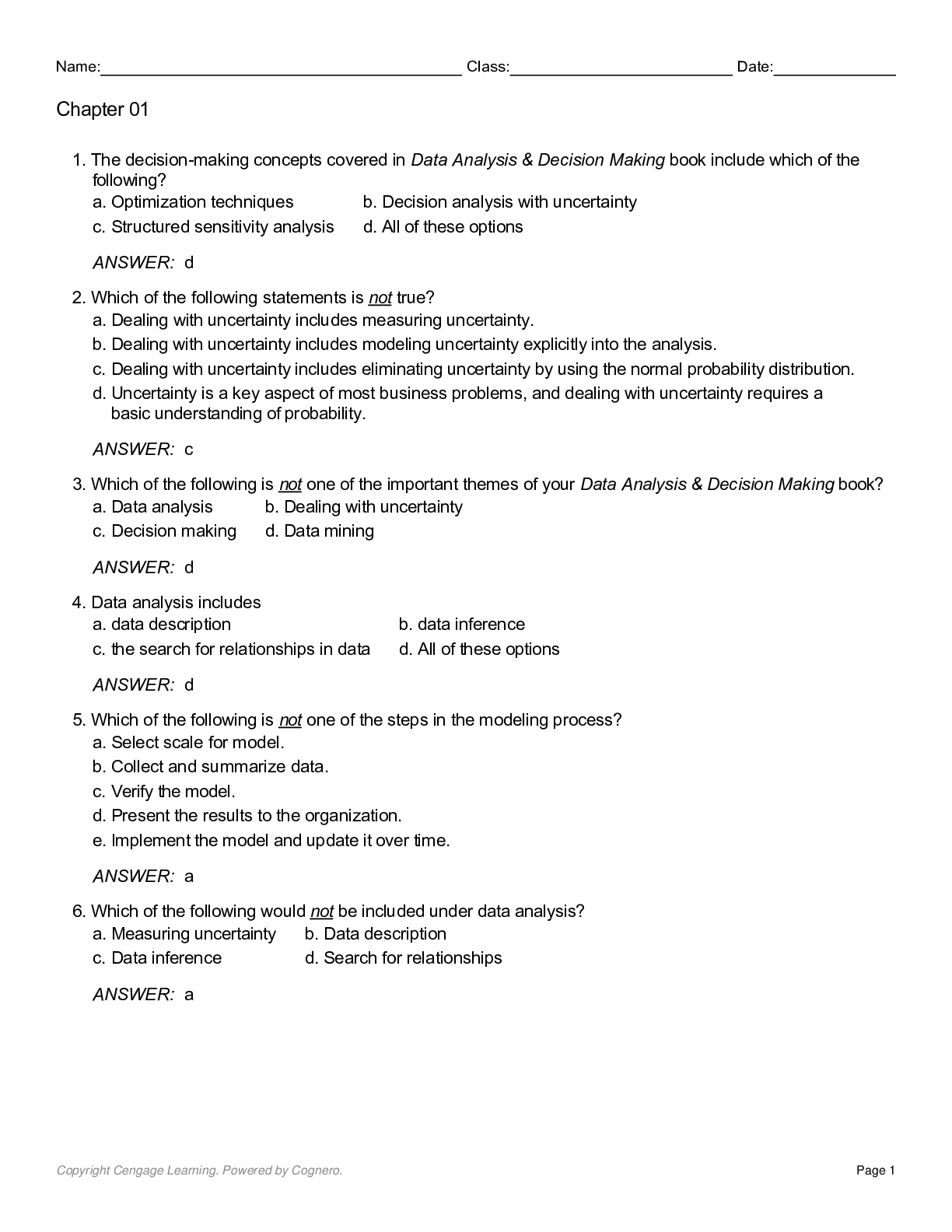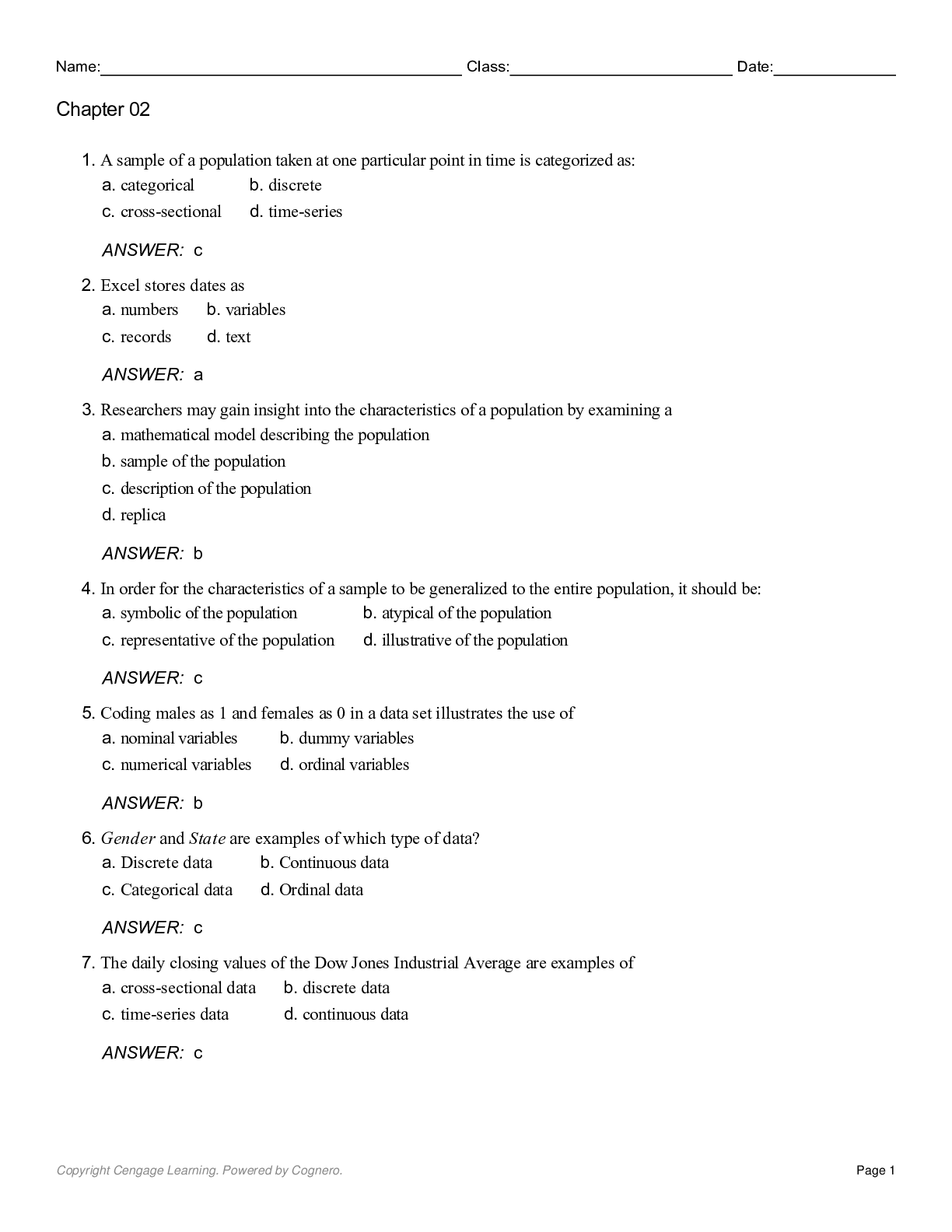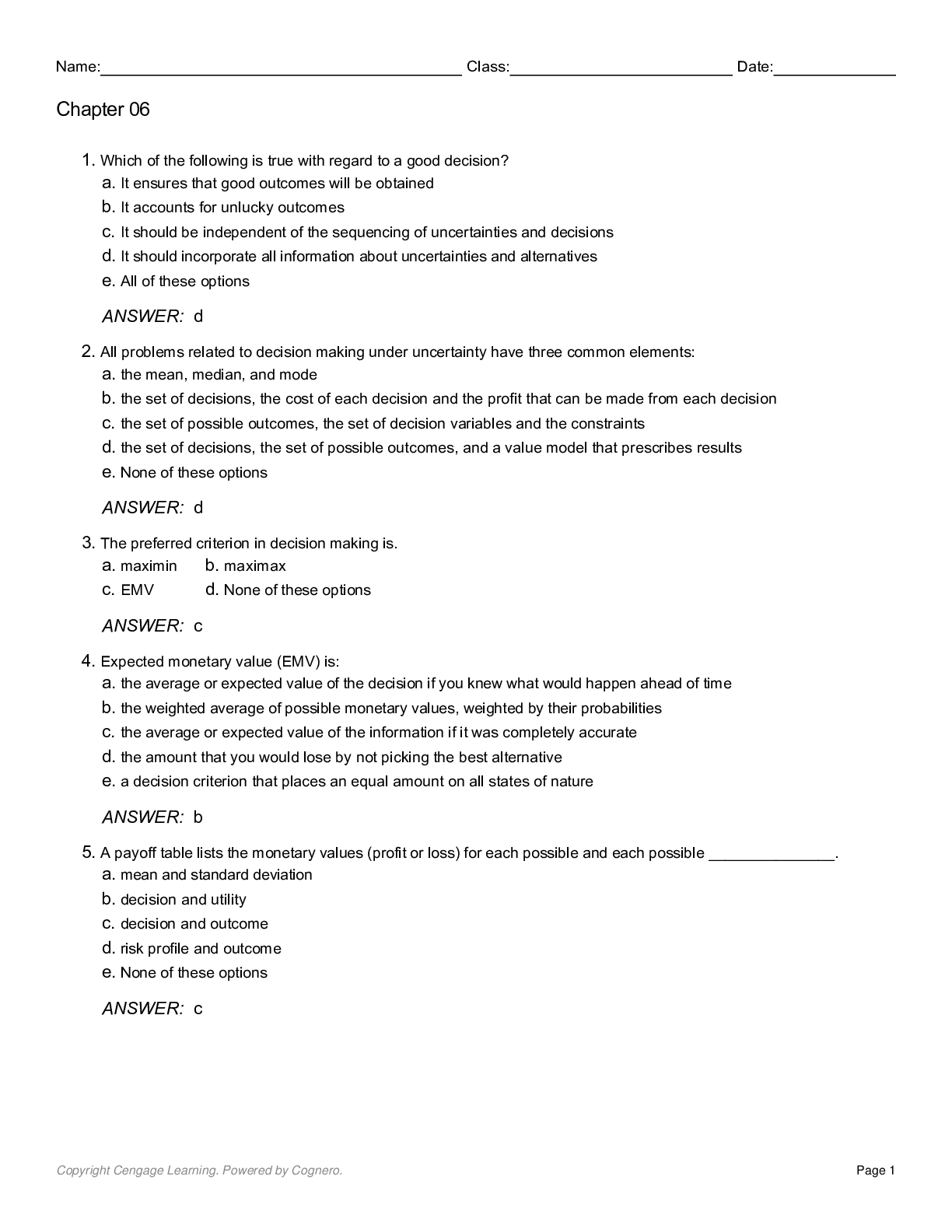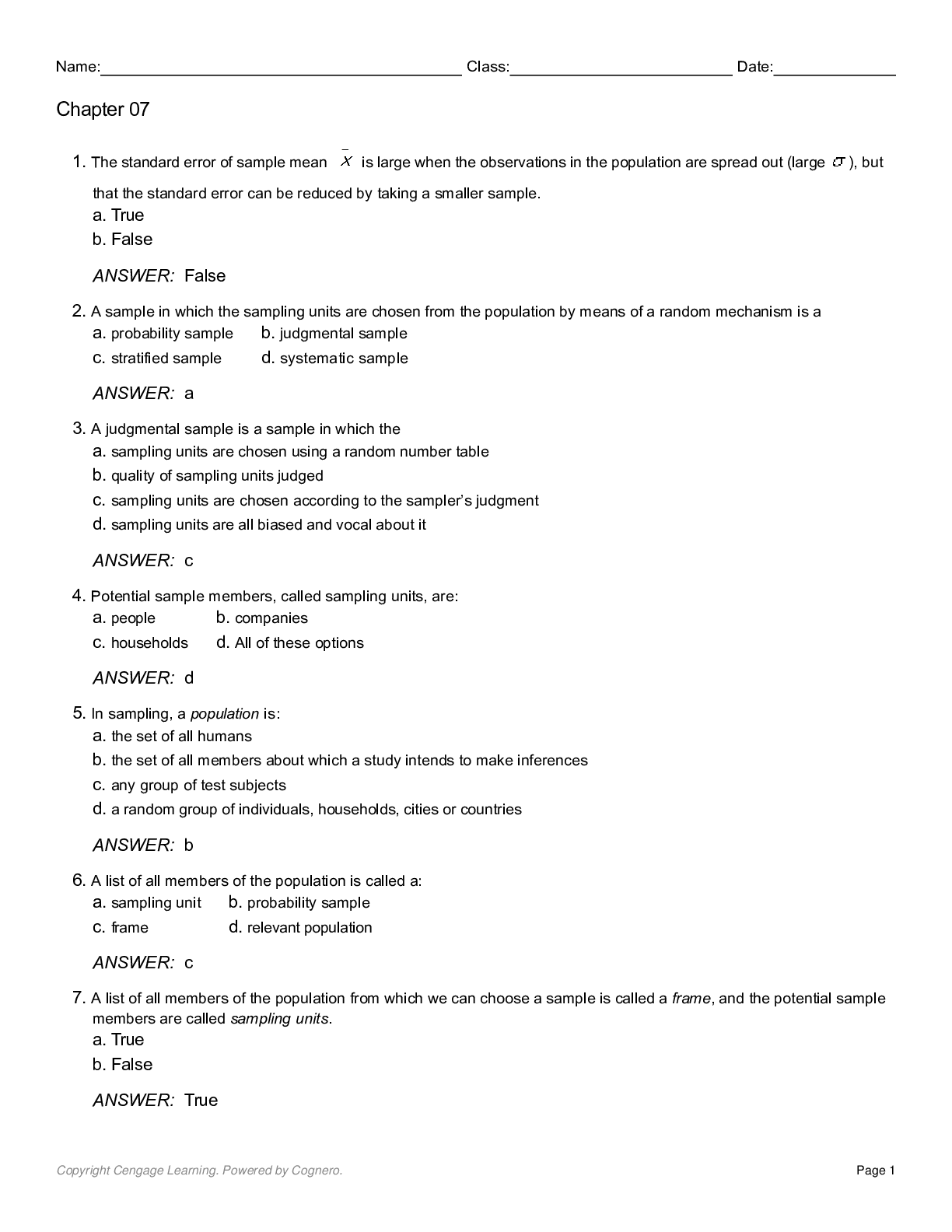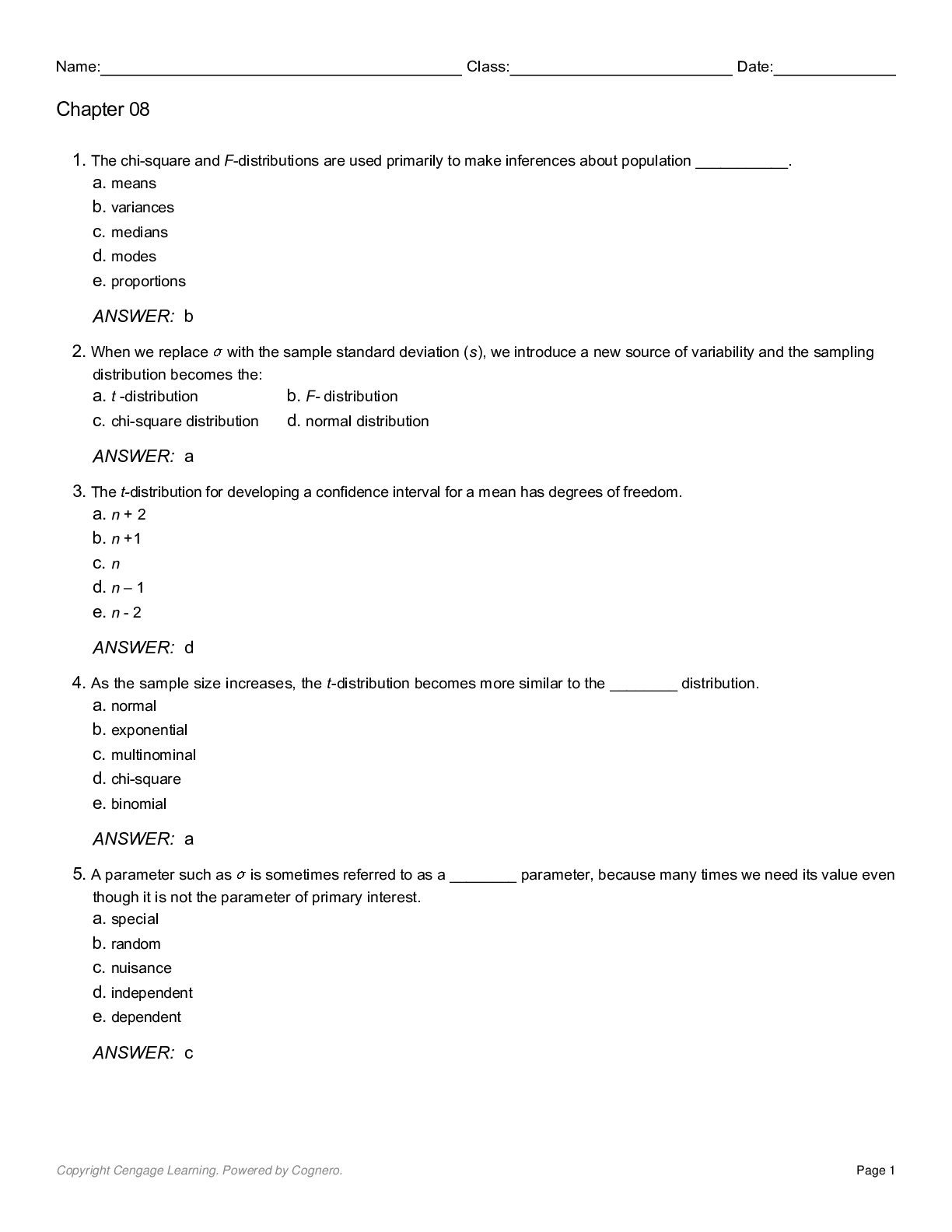Business Analytics > QUESTIONS & ANSWERS > Chapter 9: Business Analytics_ Data Analysis _ Decision Making (All)
Chapter 9: Business Analytics_ Data Analysis _ Decision Making
Document Content and Description Below
1. The null hypothesis usually represents the: a. theory the researcher would like to prove. b. preconceived ideas of the researcher c. perceptions of the sample population d. status quo 2. In st... atistical analysis, the burden of proof lies traditionally with the: a. alternative hypothesis b. null hypothesis c. analyst d. facts presented to the statistical analyst 3. The hypothesis that an analyst is trying to prove is called the: a. elective hypothesis b. alternative hypothesis c. optional hypothesis d. null hypothesis 4. The alternative hypothesis is also known as the: a. elective hypothesis b. optional hypothesis c. research hypothesis d. null hypothesis 5. A null hypothesis is a statement about the value of a population parameter. It is usually the current thinking, or “status quo”. a. True b. False 6. An alternative or research hypothesis is usually the hypothesis a researcher wants to prove. a. True b. False 7. One-tailed alternatives are phrased in terms of: a. ≠ b. < or > c. = d. Copyright Cengage Learning. Powered by Cognero. Page 1 Name: Class: Date: Chapter 09 8. A type II error occurs when: a. the null hypothesis is incorrectly accepted when it is false b. the null hypothesis is incorrectly rejected when it is true c. the sample mean differs from the population mean d. the test is biased 9. Of type I and type II error, which is traditionally regarded as more serious? a. Type I b. Type II c. Type I and Type II are equally serious d. Neither Type I or Type II is serious and both can be avoided 10. The form of the alternative hypothesis can be: a. one-tailed b. two-tailed c. neither one nor two-tailed d. one or two-tailed 11. A two-tailed test is one where: a. results in only one direction can lead to rejection of the null hypothesis b. negative sample means lead to rejection of the null hypothesis c. results in either of two directions can lead to rejection of the null hypothesis d. no results lead to the rejection of the null hypothesis 12. The value set for is known as: a. the rejection level b. the acceptance level c. the significance level d. the error in the hypothesis test 13. Which of the following statements are true of the null and alternative hypotheses? a. Exactly one hypothesis must be true b. Both hypotheses must be true c. It is possible for both hypotheses to be true d. It is possible for neither hypothesis to be true Copyright Cengage Learning. Powered by Cognero. Page 2 Name: Class: Date: Chapter 09 14. Which of the following values is not typically used for ? a. 0.01 b. 0.05 c. 0.10 d. 0.50 15. Smaller p-values indicate more evidence in support of the: a. null hypothesis b. alternative hypothesis c. quality of the researcher d. None of these options 16. A p-value is considered “convincing” if it is: a. less than 0.01 b. between 0.01 and 0.05 c. between 0.05 and 0.10 d. greater than 0.10 17. A null hypothesis can only be rejected at the 5% significance level if and only if: a. a 95% confidence interval includes the hypothesized value of the parameter b. a 95% confidence interval does not include the hypothesized value of the parameter c. the null hypothesis is biased d. the null hypotheses includes sampling error 18. The null and alternative hypotheses divide all possibilities into: a. two sets that overlap b. two non-overlapping sets c. two sets that may or may not overlap d. as many sets as necessary to cover all possibilities 19. The p–value of a sample is the probability of seeing a sample with a. at most as much evidence in favor of the null hypothesis as the sample actually observed. b. at most as much evidence in favor of the alternative hypothesis as the sample actually observed. c. at least as much evidence in favor of the null hypothesis as the sample actually observed. d. at least as much evidence in favor of the alternative hypothesis as the sample actually observed. Copyright Cengage Learning. Powered by Cognero. Page 3 Name: Class: Date: Chapter 09 20. If a teacher is trying to prove that new method of teaching economics is more effective than traditional one, he/she will conduct a: a. one-tailed test b. two-tailed test c. point estimate of the population parameter d. confidence interval 21. A type I error occurs when the: a. null hypothesis is incorrectly accepted when it is false b. null hypothesis is incorrectly rejected when it is true c. sample mean differs from the population mean d. test is biased 22. The power of a test is the probability that we a. reject the null hypothesis when the alternative hypothesis is false b. reject the null hypothesis when the alternative hypothesis is true c. accept the null hypothesis when the alternative hypothesis is false d. accept the null hypothesis when the alternative hypothesis is true 23. Which of the following signs is possible in an alternative hypothesis? a. > b. < c. ≠ d. All of these options 24. An alternative hypothesis can have the signs >, <, or ≠. a. True b. False 25. A one-tailed alternative is one that is supported by evidence in either direction. a. True b. False Copyright Cengage Learning. Powered by Cognero. Page 4 Name: Class: Date: Chapter 09 26. The rejection region is the set of sample data that leads to the rejection of the alternative hypothesis. a. True b. False 27. A Type I error probability is represented by ; it is the probability of incorrectly rejecting a null hypothesis that is true. a. True b. False 28. Type I errors are usually considered more “costly” although this can lead to conservative decision making. a. True b. False 29. The probability of making a Type I error and the level of significance are the same. a. True b. False 30. A Type II error is committed when we incorrectly accept an alternative hypothesis that is false. a. True b. False 31. The analyst gets to choose the significance level . It is typically chosen to be 0.50, but it is occasionally chosen to be 0.05. a. True b. False 32. The significance level also determines the rejection region. a. True b. False 33. Sample evidence is statistically significant at the level only if the p–value is larger than . a. True b. False Copyright Cengage Learning. Powered by Cognero. Page 5 Name: Class: Date: Chapter 09 34. The p-value of a test is the smallest level of significance at which the null hypothesis can be rejected. a. True b. False 35. The p-value of a test is the probability of observing a test statistic at least as extreme as the one computed given that the null hypothesis is true. a. True b. False 36. A low p–value provides evidence for accepting the null hypothesis and rejecting the alternative. a. True b. False 37. If a null hypothesis about a population mean is rejected at the 0.025 level of significance, then it must also be rejected at the 0.01 level. a. True b. False 38. A professor of statistics refutes the claim that the proportion of Republican voters in Michigan is at most 45%. To test the claim, the hypotheses: , should be used. a. True b. False 39. Which of the following values is typically used for ? a. 0.50 b. 0.40 c. 0.30 d. 0.10 40. Larger p-values indicate more evidence in support of the: a. null hypothesis b. alternative hypothesis c. quality of the researcher d. None of these options Copyright Cengage Learning. Powered by Cognero. Page 6 Name: Class: Date: Chapter 09 41. A null hypothesis can only be rejected at the 10% significance level if and only if: a. a 90% confidence interval includes the hypothesized value of the parameter b. a 90% confidence interval does not include the hypothesized value of the parameter c. the null hypothesis is biased d. the null hypotheses includes sampling error 42. A test with a 0.05 significance level has a larger rejection region than a test with a 0.01 significance level. a. True b. False 43. A test with a 0.10 significance level has a larger rejection region than a test with a 0.05 significance level. a. True b. False Copyright Cengage Learning. Powered by Cognero. Page 7 Name: Class: Date: Chapter 09 Suppose a firm that produces light bulbs wants to know whether it can say that its light bulbs typically last more than 1500 hours. Hoping to find support for their claim, the firm collects a random sample and records the lifetime (in hours) of each bulb. The information related to the hypothesis test is presented below. Test of 1500 versus one-tailed alternative Hypothesized mean 1500.0 Sample mean 1509.5 Std error of mean 4.854 Degrees of freedom 24 t-test statistic 1.953 p-value 0.031 44. (A) Can the sample size be determined from the information above? Yes or no? If yes, what is the sample size in this case? (B) The firm believes that the mean life is actually greater than 1500 hours, should you conduct a one-tailed or a two-tailed hypothesis test? Explain your answer, and state the appropriate null and alternative hypotheses. (C) What is the sample mean of this data? If you use a 5% significance level, would you conclude that the mean life of the light bulbs is typically more than 1500 hours? Explain your answer. (D) If you were to use a 1% significance level in this case, would you conclude that the mean life of the light bulbs is typically more than 1500 hours? Explain your answer. Copyright Cengage Learning. Powered by Cognero. Page 8 Name: Class: Date: Chapter 09 A study is performed in San Antonio to determine whether the average weekly grocery bill per five-person family in the town is significantly different from the national average. A random sample of 50 five-person families in San Antonio showed a mean of $133.474 and a standard deviation of $11.193. 45. (A) Assume that the national average weekly grocery bill for a five-person family is $131. Is the sample evidence statistically significant? If so, at what significance levels can you reject the null hypothesis? (B) For which values of the sample mean (i.e., average weekly grocery bill) would you decide to reject the null hypothesis at the significance level? For which values of the sample mean would you decide to reject the null hypothesis at the 10% level of significance? Copyright Cengage Learning. Powered by Cognero. Page 9 Name: Class: Date: Chapter 09 46. (A) Specify a hypothesis test to test the foundation’s claim (B) Compared to the most recent survey, is this sample evidence statistically significant at the 10% level? (C) Compared to the most recent survey, is this sample evidence statistically significant at the 5% level? (D) Report and interpret the p-value for this test (E) Interpret the overall test for the foundation. (A) H0: μ 100,000 H a: μ 100,000 (B) The StatTools output above shows the sample mean is significantly different from $100,000 at the 10% level; therefore they can reject the null hypothesis. (C) The StatTools output shown for (B) above shows the sample mean is not significantly different from $100,000 at the 5% level; therefore they cannot reject the null hypothesis. (D) The StatTools output shown for (B) above shows a p-value of 0.053. This shows that the sample results were very close to being significant at the 5% level. (E) This test shows that there is some evidence that the average annual donor income his increased, but it is not quite strong (5% level) or convincing (1% level). Copyright Cengage Learning. Powered by Cognero. Page 10 Name: Class: Date: Chapter 09 47. The test statistic in a hypothesis test for a population proportion is a. t-value calculated from the sample b. z-value calculated from the sample c. F-value calculated from the sample d. the sample proportion 48. The test statistic for a hypothesis test of a population proportion is the z-value. a. True b. False 49. In testing the difference between two population means using two independent samples, we use the pooled variance in estimating the standard error of the sampling distribution of the sample mean difference if the populations are normal with equal variances. a. True b. False 50. In conducting hypothesis testing for difference between two means when samples are dependent (paired samples), the variable under consideration is ; the sample mean difference between the pairs. a. True b. False 51. When testing the equality of two population variances, the test statistic is the ratio of the population variances; namely . a. True b. False 52. The test statistic employed to test , which is F distributed with degrees of freedom. a. True b. False 53. Side–by–side box–plots are typically a good way to begin the analysis when comparing two populations. a. True b. False Copyright Cengage Learning. Powered by Cognero. Page 11 Name: Class: Date: Chapter 09 The CEO of a software company is committed to expanding the proportion of highly qualified women in the organization’s staff of salespersons. He believes that the proportion of women in similar sales positions across the country in 2004 is less than 45%. Hoping to find support for his belief, he directs his assistant to collect a random sample of salespersons employed by his company, which is thought to be representative of sales staffs of competing organizations in the industry. The collected random sample of size 50 showed that only 18 were women. 54. (A) State the appropriate null and alternative hypotheses in this situation. (B) Test this CEO’s belief at the =.05 significance level and report the p-value. Do you find statistical support for his hypothesis that the proportion of women in similar sales positions across the country is less than 40%? (C) Suppose the sample size above is 100, instead of 50, and the sample proportion is again 0.36. Would this change your results in (B)? Explain your answer. 55. (A) If you were to conduct a hypothesis test to determine if greater than 50% of customers prefer Coca-Cola to other brands, would you conduct a one-tail or a two-tail hypothesis test? Explain your answer. (B) How many customers out of the 200 sampled must have favored Coke in this case? (C) Using a 5% significance level, can the marketing consultant conclude that the proportion of customers who prefer Coca-Cola exceeds 50%? Explain your answer. (D) If you were to use a 1% significance level, would the conclusion from (C) change? Explain your answer.. Copyright Cengage Learning. Powered by Cognero. Page 13 Name: Class: Date: Chapter 09 The owner of a popular Internet-based auction site believes that more than half of the people who sell items on her site are women. To test this hypothesis, the owner sampled 1000 customers who sold items on her site and she found that 53% of the customers sampled were women. Some calculations are shown in the table below Sample proportion 0.53 Standard error of sample proportion 0.01578 Z test statistic 1.9008 p-value 0.0287 56. (A) If you were to conduct a hypothesis test to determine if greater than 50% of customers who use this Internet-based site are women, would you conduct a one-tail or a two-tail hypothesis test? Explain your answer, and state the appropriate null and alternative hypotheses. (B) How many customers out of the 1000 sampled must have been women in this case? (C) Using a 5% significance level, can the owner of this site conclude that women make up more than 50% of her customers? Explain your answer. (D) If you were to use a 1% significance level, would the conclusion from (C) change? Explain your answer. Copyright Cengage Learning. Powered by Cognero. Page 15 Name: Class: Date: Chapter 09 57. (A) Is this two-sample data or paired data. Explain your answer. (B) Specify an appropriate hypothesis test. (C) Using a 10% level of significance, do the given sample data support that the firm’s training programs is effective in increasing the new employee’s computer skills? (D) Using a 1% level of significance, do the given sample data support that the firm’s training programs is effective in increasing the new employee’s working knowledge of computing? Copyright Cengage Learning. Powered by Cognero. Page 16 Name: Class: Date: Chapter 09 Sample standard deviations 1937.52 2983.39 Test of difference 0 Results if Results if Sample mean difference 2685.5 Pooled standard deviation 2515.41 NA Std error of difference 795.44 795.44 Degrees of freedom 38 33 t-test statistic 3.376 3.376 p-value 0.0009 0.0009 Test of equality of variances Ratio of sample variances 2.371 p-value 0.034 58. (A) Use the information above to perform the test of equal variance. Explain how the ratio of sample variances is calculated. What type of distribution is used to test for equal variances? Also, would you conclude that the variances are equal or not? Explain. (B) Based on your conclusion in (A), which test statistic should be used in performing a test for the existence of a difference between population means? (C) Using a 5% level of significance, is there sufficient evidence to conclude that IS majors earn, on average, a higher annual starting salaries than their peers who major in Mktg? (D) Using a 1% level of significance, is there sufficient evidence to conclude that IS majors earn, on average, a higher annual starting salaries than their peers who major in Mktg? Explain your answer. Copyright Cengage Learning. Powered by Cognero. Page 17 Name: Class: Date: Chapter 09 Summary statistics for two samples Q-Mart Other Charges Sample sizes 13 25 Sample means 192.81 104.47 Sample standard deviations 115.243 71.139 Test of difference = 0 Sample mean difference 88.34 Pooled standard deviation 88.323 Std error of difference 30.201 t-test statistic 2.925 p-value 0.006 59. (A) Given the information above, what is for this comparison? Also, does this represent a one-tailed or a twotailed test? Explain your answer. (B) What are the degrees of freedom for the t-statistic in this calculation? Explain how you would calculate the degrees of freedom in this case. (C) What is the assumption in this case that allows you to use the pooled standard deviation for this test? (D) Using a 5% level of significance, is there sufficient evidence for Q-Mart to conclude that customers who use the Q-Mart card charge, on average, more than those who use another charge card? Explain your answer. (E) Using a 1% level of significance, is there sufficient evidence for Q-Mart to conclude that customers who use the Q-Mart card charge, on average, more than those who use another charge card? Explain your answer.Copyright Cengage Learning. Powered by Cognero. Page 18 Name: Class: Date: Chapter 09 191.33 172.34 s 32.60 16.92 n 60 99 60. (A) Is there evidence of a significant difference in the average appraised values for single-family homes in the two Michigan cities? Use 0.05 level of significance. (B) Have any of the assumptions made in (A) been violated? Explain. (C) Construct a 95% confidence interval estimate of the difference between the population means of Lansing and Grand Rapids. (D) Explain how to use the confidence interval in (C) to answer (A). 61. An investor wants to compare the risks associated with two different stocks. One way to measure the risk of a given stock is to measure the variation in the stock’s daily price changes. The investor obtains a random sample of 20 daily price changes for stock 1 and 20 daily price changes for stock 2. These data are shown in the table below. Show how this investor can compare the risks associated with the two stocks by testing the null hypothesis that the variances of the stocks are equal. Use = 0.10 and interpret the results of the statistical test. Day Price Change for stock 1 Price Change for stock 2 1 1.86 0.87 2 1.80 1.33 3 1.03 -0.27 4 0.16 -0.20 5 -0.73 0.25 6 0.90 0.00 7 0.09 0.09 8 0.19 -0.71 9 -0.42 -0.33 10 0.56 0.12 11 1.24 0.43 12 -1.16 -0.23 13 0.37 0.70 14 -0.52 -0.24 15 -0.09 -0.59 16 1.07 0.24 17 -0.88 0.66 18 0.44 -0.54 19 -0.21 0.55 20 0.84 0.08 Copyright Cengage Learning. Powered by Cognero. Page 20 Name: Class: Date: Chapter 09 Test statistic: F-value= and p-value=0.023 Since the p-value is less than 0.10, we reject the null hypothesis of equal variances and conclude that the variances of the stocks are not equal at the 10% level. Copyright Cengage Learning. Powered by Cognero. Page 21 Name: Class: Date: Chapter 09 Two teams of workers assemble automobile engines at a manufacturing plant in Michigan. A random sample of 145 assemblies from team 1 shows 15 unacceptable assemblies. A similar random sample of 125 assemblies from team 2 shows 8 unacceptable assemblies. 62. (A) Construct a 90% confidence interval for the difference between the proportions of unacceptable assemblies generated by the two teams. (B) Based on the confidence interval constructed in (A), is there sufficient evidence to conclude, at the 10% significance level, that the two teams differ with respect to their proportions of unacceptable assemblies? (C) Is there sufficient evidence to conclude, at the 10% significance level, that the two teams differ with respect to their proportions of unacceptable assemblies? Conduct the appropriate hypothesis test. (D) Calculate the p-value and explain how to use it for testing the null hypothesis of equal proportion. Chapter 09 In a survey of 1,500 customers who did holiday shopping on line during the 2000 holiday season, 270 indicated that they were not satisfied with their experience. Of the customers that were not satisfied, 143 indicated that they did not receive the products in time for the holidays, while 1,197 of the customers that were satisfied with their experience indicated that they did receive the products in time for the holidays. The following complete summary of results was reported: Satisfied with their experience Yes (in time) No (not in time) Total Yes 1,197 33 1,230 No 127 143 270 Total 1,324 176 1,500 63. (A) Is there a significant difference in satisfaction between those who received their products in time for the holidays, and those who did not receive their products in time for the holidays? Test at the 0.01 level of significance. (B) Find the p-value associated with the test in part (A) and interpret its meaning. (C) Based on the results of (A) and (B), if you were the marketing director of a company selling products online, what would you do to improve the satisfaction of the customers? Copyright Cengage Learning. Powered by Cognero. Page 23 Name: Class: Date: Chapter 09 64. The chi-square goodness-of-fit test can be used to test for: a. significance of sample statistics b. difference between population means c. normality d. difference between population variances 65. An informal test for normality that utilizes a scatterplot and looks for clustering around a 45° line is known as a(n): a. Lilliefors test b. empirical cumulative distribution function c. p-test d. quantile-quantile plot 66. Which pair of the following tests is used to test for normality? a. A t-test and an ANOVA test b. An Empirical cumulative distribution function test and an F-test c. A Chi-Square test and a Lilliefors test d. A Quantile-Quantile plot and a p-value test 67. Which of the following statements are true regarding the chi–square goodness-of-fit test for normality? a. The test does depend on which and how many categories we use for the histogram. b. The test is not very effective unless the sample size is large, say, at least 80 or 100. c. The test tends to be too sensitive if the sample size is really large. d. None of these options e. All of these options 68. The chi–square test for normality makes a comparison between the observed histogram and a histogram based on normality. a. True b. False 69. The Lilliefors test is used to test for normality. a. True b. False Copyright Cengage Learning. Powered by Cognero. Page 24 Name: Class: Date: Chapter 09 70. Lilliefors test for normality compare two cumulative distribution functions (cdf’s): the cdf from a normal distribution and the cdf corresponding to the given data (called the empirical cdf). a. True b. False 71. A test for independence is applied to a contingency table with 4 rows and 4 columns. The degrees of freedom for this chi-square test must equal 9. a. True b. False Copyright Cengage Learning. Powered by Cognero. Page 25 Name: Class: Date: Chapter 09 72. A statistics professor has just given a final examination in his linear models course. He is particularly interested in determining whether the distribution of 50 exam scores is normally distributed. The data are shown in the table below. Perform the Lilliefors test. Report and interpret the results of the test. 77 71 83 78 84 71 81 82 79 71 73 89 74 75 93 74 88 83 90 82 79 62 73 88 76 76 76 80 84 84 91 70 76 74 68 80 87 92 84 79 80 91 74 69 88 84 83 87 82 72 Copyright Cengage Learning. Powered by Cognero. Page 26 Name: Class: Date: Chapter 09 73. A chi-square goodness-of-fit test can be used to test for normality. a. True b. False 74. A Q-Q plot can be used to test for normality. a. True b. False 75. The idea of the chi–square test for independence is to: a. compare the quantile-quantile (Q-Q) plot with what would be expected under independence b. compare the actual counts in a contingency table with what would be expected under independence c. compare the cumulative distribution with what would be expected under independence d. None of these options 76. Tests in which samples are not independent are referred to as matched pairs or paired samples. a. True b. False 77. An example of a paired sample is the number of defective computer chips of a particular type from two different manufacturers. a. True b. False Copyright Cengage Learning. Powered by Cognero. Page 27 Name: Class: Date: Chapter 09 An automobile manufacturer needs to buy aluminum sheets with an average thickness of 0.05 inch. The manufacturer collects a random sample of 40 sheets from a potential supplier. The thickness of each sheet in this sample is measured (in inches) and recorded. The information below pertains to the Chi-square goodness-of-fit test. Upper limit Category Frequency Normal Distance measure 0.03 0.03 1 1.920 0.441 0.04 0.03 but 0.04 10 8.074 0.459 0.05 0.04 but 0.05 13 14.947 0.254 0.06 0.05 but 0.06 12 11.218 0.055 >0.06 4 3.842 0.007 Test of normal fit Chi-square statistic 1.214 p-value 0.545 78. (A) Are these measurements normally distributed? Summarize your results. (B) Are there any weaknesses or concerns about your conclusions in (A)? Explain Name: Class: Date: Chapter 09 79. A sport preference poll yielded the following data for men and women. Use the 5% significance level and test to determine if sport preference and gender are independent. Sport Preference Gender Basketball Football Soccer Men 20 25 30 75 Women 18 12 15 45 38 37 45 120 Copyright Cengage Learning. Powered by Cognero. Page 29 Name: Class: Date: Chapter 09 80. A recent study of educational levels of 1000 voters and their political party affiliations in a Midwestern state showed the results given in the table below. Use = .10 and test to determine if party affiliation is independent of the educational level of the voters. Party Affiliation Educational Level Democrat Republican Independent Didn't Complete High School 95 80 115 290 Has High School Diploma 135 85 105 325 Has College Degree 160 105 120 385 390 270 340 1000 Copyright Cengage Learning. Powered by Cognero. Page 30 Name: Class: Date: Chapter 09 81. The number of cars sold by three salespersons over a 6-month period are shown in the table below. Use the 5% level of significance to test for independence of salespersons and type of car sold. Insurance Preference Chevrolet Ford Toyota Ali 15 9 5 29 Bill 20 8 15 43 Chad 13 4 11 28 48 21 31 100 Copyright Cengage Learning. Powered by Cognero. Page 31 Name: Class: Date: Chapter 09 82. An insurance firm interviewed a random sample of 600 college students to find out the type of life insurance preferred, if any. The results are shown in the table below. Is there evidence that life insurance preference of male students is different than that of female students. Test at the 5% significance level. Insurance Preference Gender Term Whole Life No Insurance Male 80 30 240 350 Female 50 40 160 250 130 70 400 600 83. The power of a test is the probability of rejecting the null hypothesis when the alternative hypothesis is true. a. True b. False Copyright Cengage Learning. Powered by Cognero. Page 32 Name: Class: Date: Chapter 09 Do graduates of undergraduate business programs with different majors tend to earn disparate starting salaries? Below you will find output from an analysis for randomly selected graduates with majors in accounting (Acct) and marketing (Mktg). t‐Test: Two‐Sample Assuming Unequal Variances Acct. Mktg Mean 51380 47915.6 Variance 170545600 219754013.4 Observations 6 6 Hypothesized Mean Difference 0 df 10 t Stat 0.430 P(T<=t) one‐tail 0.338 t Critical one‐tail 1.812 P(T<=t) two‐tail 0.677 t Critical two‐tail 2.228 84. Assuming that the variances of the underlying populations are unequal, can you reject at a 5% significance level that the mean starting salaries for accounting and marketing majors are the same? Explain why or why not? 85. If instead the variances in the underlying populations in question 84 are equal, would the decision regarding the salaries change? Explain why or why not? Answer this question without re-running the hypothesis test. Copyright Cengage Learning. Powered by Cognero. Page 33 Name: Class: Date: Chapter 09 86. If instead the test is conducted at the 0.10 significance level, would the decision regarding the salaries in question 84 change? Explain why or why not? Answer this question without re-running the hypothesis test. 87. At the 0.05 level of significance, is there evidence of a significant difference in average sales among the various aisle locations? Name: Class: Date: Chapter 09 [Show More]
Last updated: 1 year ago
Preview 1 out of 34 pages
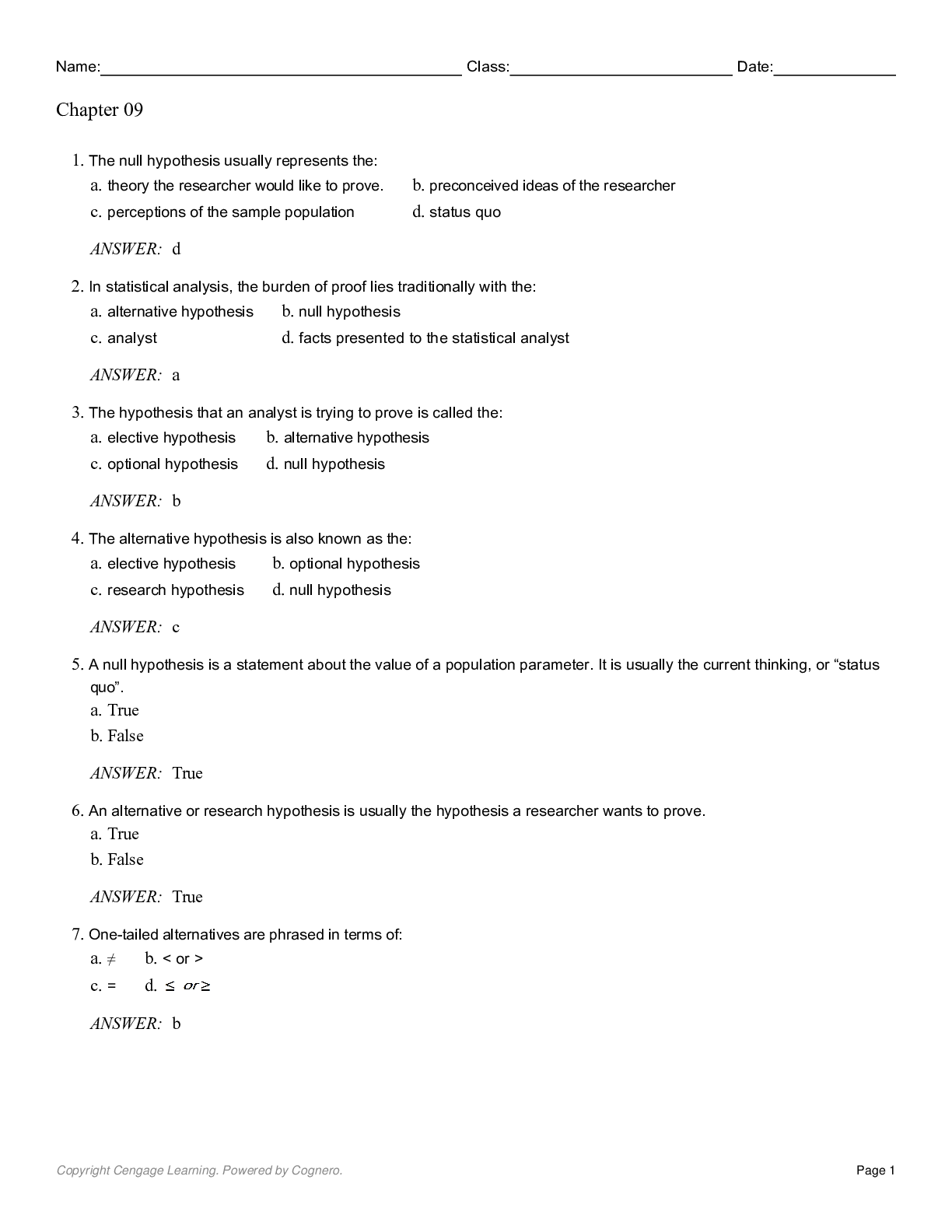
Buy this document to get the full access instantly
Instant Download Access after purchase
Add to cartInstant download
We Accept:

Reviews( 0 )
$3.00
Document information
Connected school, study & course
About the document
Uploaded On
Feb 02, 2020
Number of pages
34
Written in
Additional information
This document has been written for:
Uploaded
Feb 02, 2020
Downloads
0
Views
66

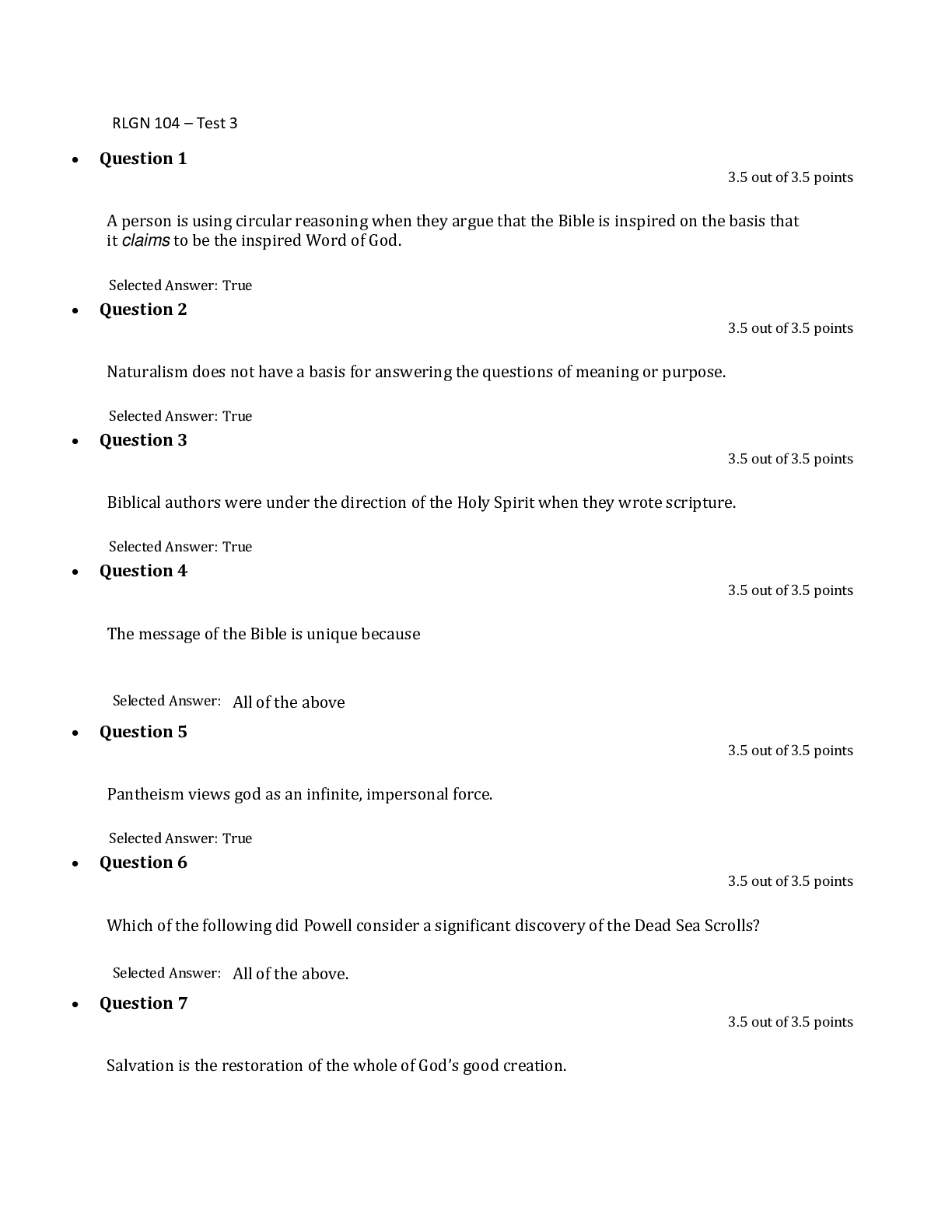


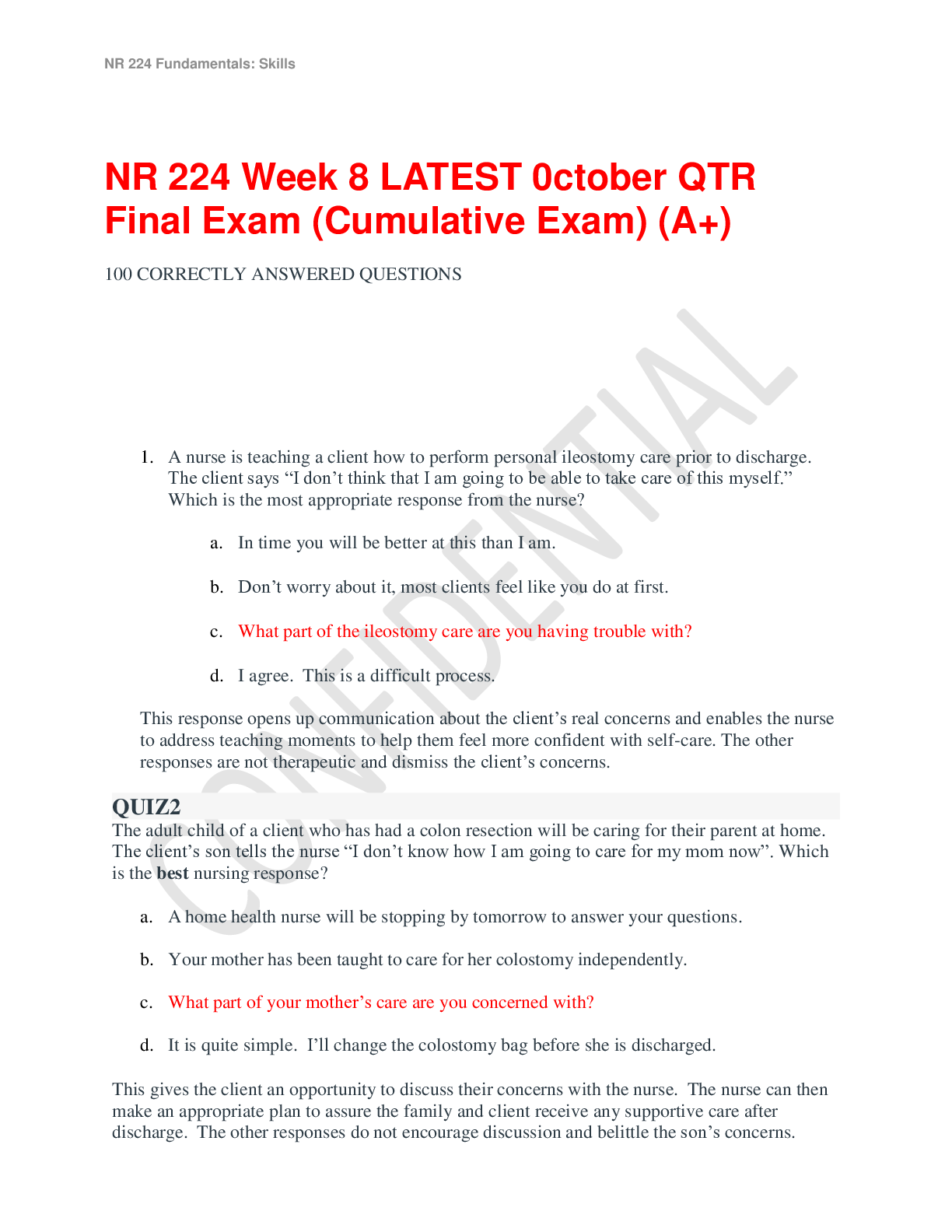


.png)




